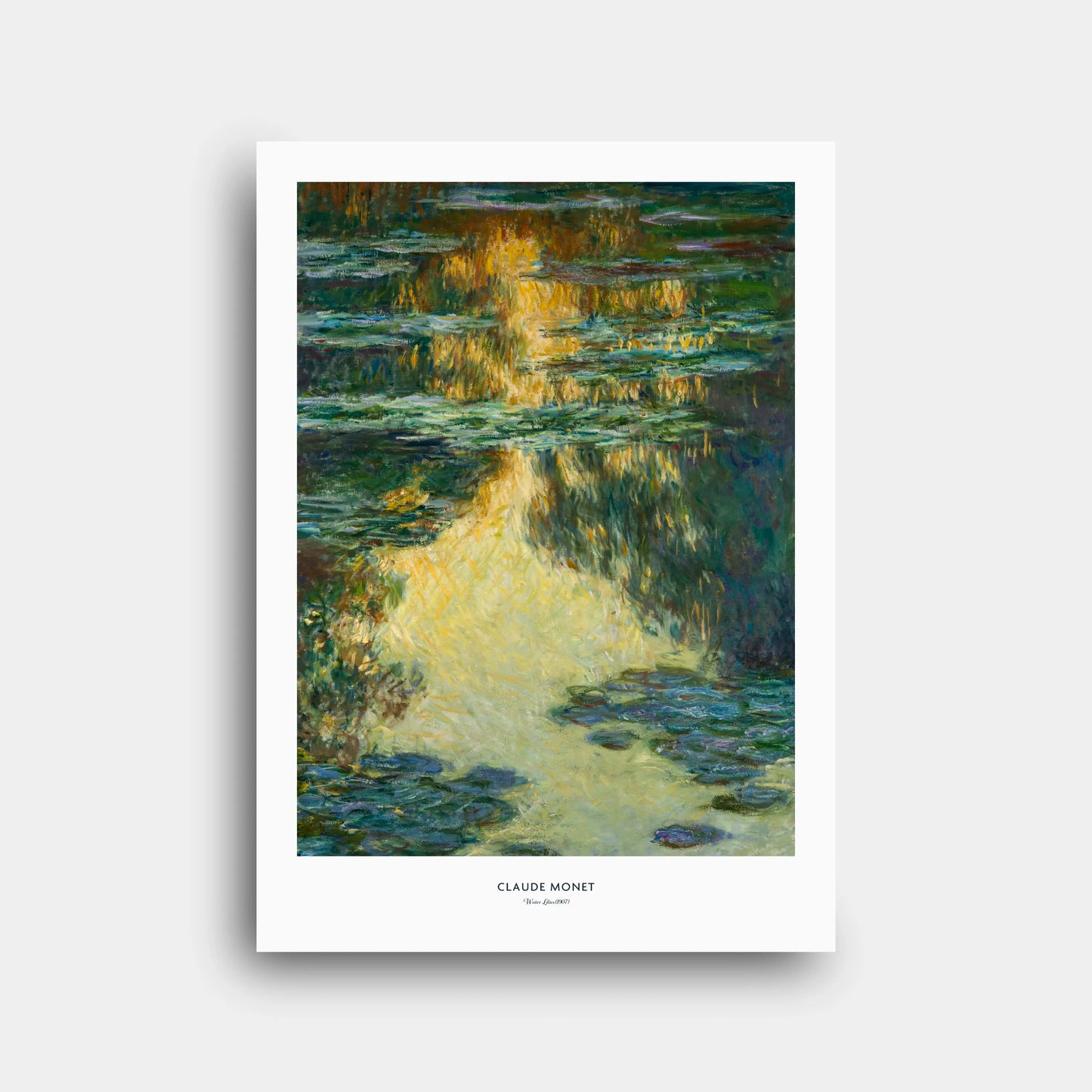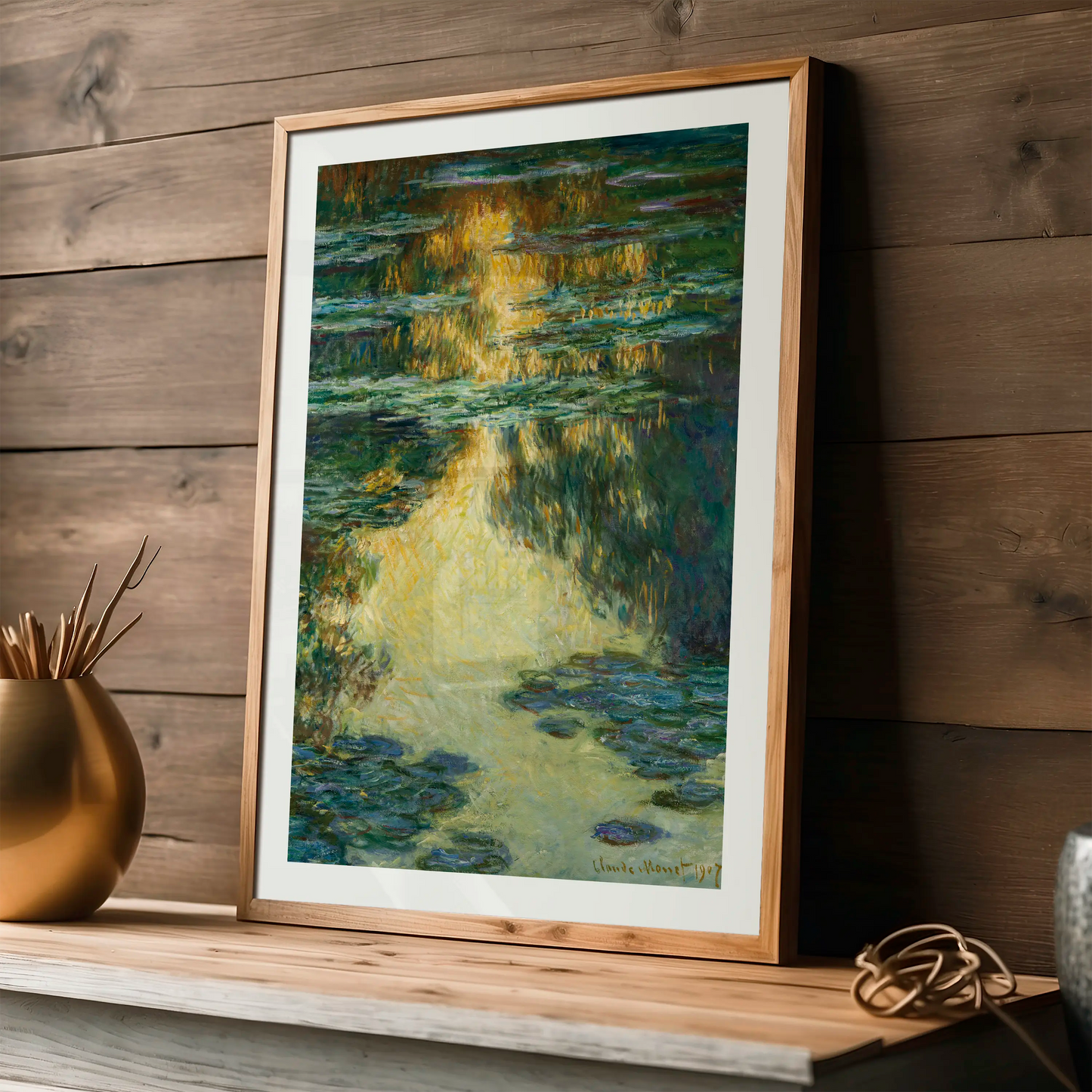Claude Monet - Water Lilies (1907) - Paper Poster N160
Claude Monet - Water Lilies (1907) - Paper Poster N160
Couldn't load pickup availability
Share
Paper Poster | Canvas Print | Digital File
1. Historical and Artistic Context
Claude Monet painted "Water Lilies" in 1907, during one of his most prolific and experimental phases at Giverny. This period followed years of cultivating his garden, transforming it into both a sanctuary and a living studio. The water-lily pond became his ultimate subject, allowing him to push Impressionism into new realms where the line between representation and abstraction began to blur. Unlike earlier landscapes, this composition avoids depicting land, sky, or horizon. Instead, it immerses the viewer in the shimmering surface of the pond, reflecting both the natural world and Monet’s personal exploration of perception and light. The series marked a turning point, setting the stage for his monumental Orangerie panels in Paris after World War I.
2. Technical and Stylistic Analysis
The painting is vertically oriented, a less common choice for the series, emphasizing the downward cascade of reflections. Monet juxtaposes patches of luminous yellow with cool greens, blues, and violets, creating an oscillation between shadow and radiance. His brushwork alternates between loose, feathery strokes and dense, textured passages that suggest both the lilies floating on the water and the vertical fall of reflected trees. There is no central focal point; rather, the surface is a field of movement and light. The elimination of perspective and horizon makes the canvas read almost like a tapestry of color, anticipating the concerns of abstract painting in the 20th century.
3. Symbolism and Interpretation
While Monet rejected overt symbolism, his Water Lilies invite layered interpretations. The reflective surface of water becomes a metaphor for transience and impermanence, capturing fleeting light and dissolving forms. The yellow blaze across the center may evoke the passage of sunlight, a symbol of time’s relentless flow. The lilies, stable yet fragile, provide anchors of continuity in an ever-changing visual field. Influences from Japanese aesthetics, particularly asymmetry and cropped composition, add a meditative and timeless quality. Many viewers have interpreted the work as spiritual, offering a contemplative space beyond narrative—a visual parallel to silence or reflection itself.
4. Technique and Materials
Monet worked in oil on canvas, approximately 92 × 81 cm, signed and dated in 1907. His palette of the period included cobalt blue, ultramarine, viridian green, cadmium yellow, vermilion, and lead white. Technical studies of related works suggest he sometimes used poppyseed oil as a binder to prevent excessive yellowing. His process was highly layered, involving wet-into-wet strokes and dry scumbles applied over earlier passages. He often returned to canvases over several seasons, adjusting tones until they conveyed the remembered light. This slow, meditative method belies the apparent spontaneity of his brushwork.
5. Cultural Impact
The Water Lilies series profoundly influenced modern art, particularly Abstract Expressionists such as Jackson Pollock and Mark Rothko, who admired Monet’s dissolution of form into pure optical experience. The works shifted landscape painting away from geographic description toward immersive environments of color and sensation. Culturally, they became icons of serenity and introspection, widely reproduced and celebrated in both high art contexts and popular culture. The series also inspired contemporary dialogues, with exhibitions pairing Monet’s canvases with modern abstraction, highlighting his role as a bridge between Impressionism and 20th-century avant-garde movements.
6. Critical Reception and Scholarly Interpretations
When shown in 1909 at the Durand-Ruel Gallery in Paris, Monet’s Water Lilies were praised for their immersive qualities. Critics marveled at their dreamlike atmosphere, describing them as aquariums of light or cosmic visions. Later scholars emphasized their pioneering abstraction, noting Monet’s radical decision to eliminate the horizon. Interpretations have ranged from considering them meditations on mortality—especially as Monet battled cataracts in later years—to seeing them as precursors of installation art. Today, scholars continue to analyze them as experiments in perception and time, balancing natural observation with modernist innovation.
7. Museum, Provenance and Exhibition History
This particular painting belongs to the Museum of Fine Arts, Houston, donated in 1968 by Mrs. Harry C. Hanszen. Its provenance includes Monet’s dealers Bernheim-Jeune and Durand-Ruel, the Parisian collector Henri Canonne, and later London dealers. It was exhibited at the groundbreaking 1909 Durand-Ruel show and has since traveled internationally, including exhibitions in Chicago, Boston, London, Paris, Basel, and Denver. Its presence in Houston reflects the global distribution of Monet’s works, many of which entered American collections in the mid-20th century.
8. Interesting Facts
1. Monet referred to these works as “water landscapes” rather than traditional landscapes.
2. The 1909 Durand-Ruel exhibition featured 48 such canvases, stunning critics and collectors.
3. Vertical compositions like this one are rare in the series.
4. Monet imported exotic lilies from abroad, shaping his pond as an artistic project.
5. His garden was designed with Japanese aesthetics in mind, including the bridge and plantings.
6. He often rotated several canvases simultaneously, switching as light conditions changed.
7. Despite their calm appearance, Monet sometimes destroyed canvases he found unsatisfactory.
8. The Orangerie installation in Paris, opened in 1927, is considered a precursor to immersive art.
9. Monet struggled with cataracts later, affecting his color perception.
10. This painting is signed and dated 1907, anchoring it firmly in the pre-war series.
9. Conclusion
"Water Lilies" (1907) epitomizes Monet’s late artistic vision, where surface and reflection merge into a continuous field of sensation. It is both deeply rooted in natural observation and radically innovative, moving toward abstraction decades before it became dominant in modern art. By focusing on perception, transience, and immersion, Monet transformed landscape painting into a meditative experience that continues to resonate with viewers today. This canvas, with its glowing vertical passage of light, stands as a testament to his enduring search for beauty in flux and harmony in impermanence.











